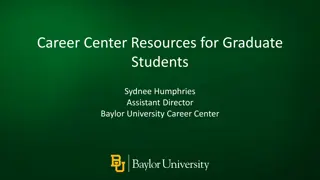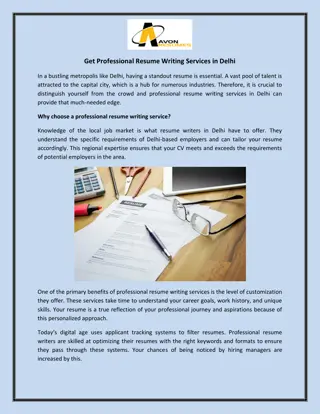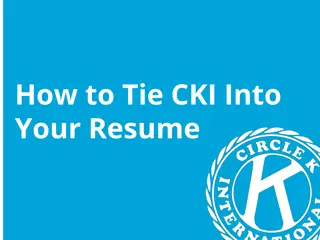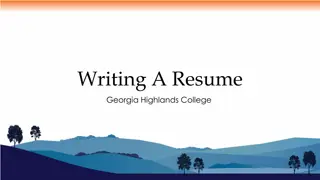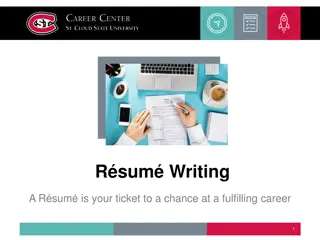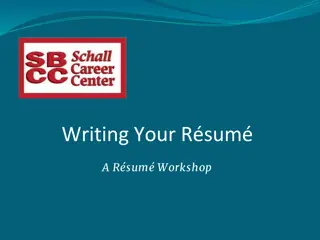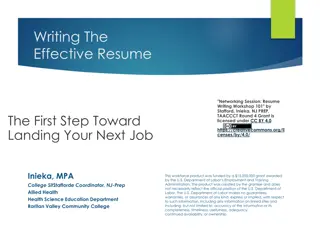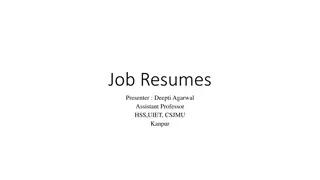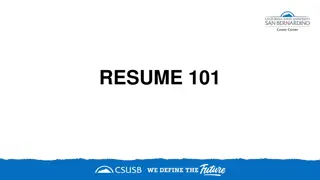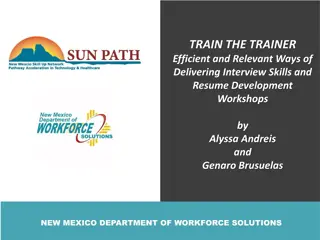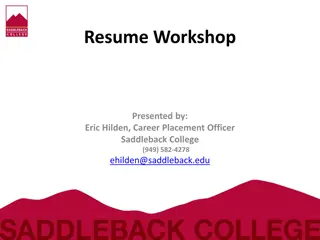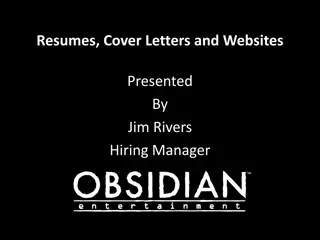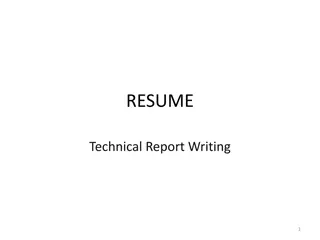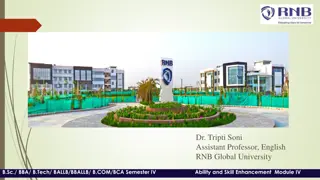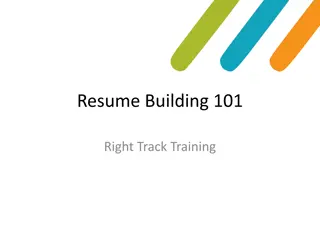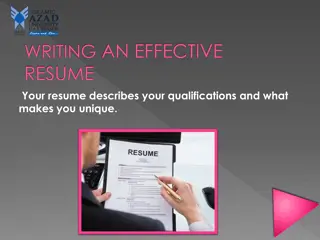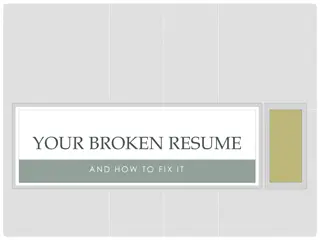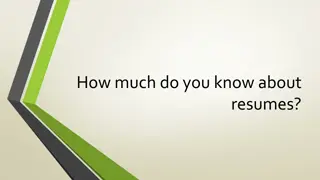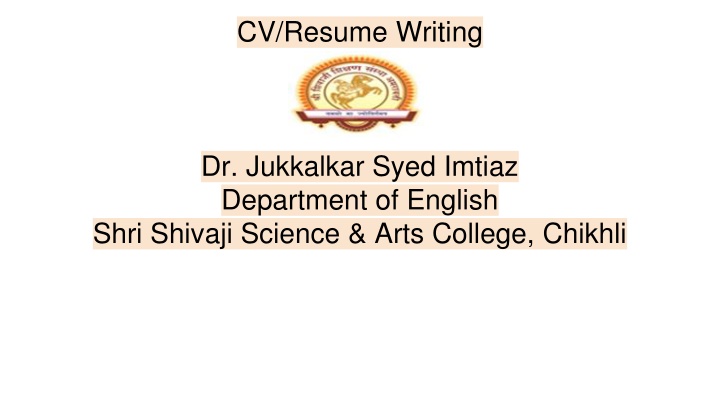
Crafting a Professional CV: A Comprehensive Guide
"Learn the essential elements and differences between a CV and resume. Discover how to structure a compelling CV with tips on writing contact information, personal statements, work experience, education, skills, and additional sections."
Download Presentation

Please find below an Image/Link to download the presentation.
The content on the website is provided AS IS for your information and personal use only. It may not be sold, licensed, or shared on other websites without obtaining consent from the author. If you encounter any issues during the download, it is possible that the publisher has removed the file from their server.
You are allowed to download the files provided on this website for personal or commercial use, subject to the condition that they are used lawfully. All files are the property of their respective owners.
The content on the website is provided AS IS for your information and personal use only. It may not be sold, licensed, or shared on other websites without obtaining consent from the author.
E N D
Presentation Transcript
CV/Resume Writing Dr. Jukkalkar Syed Imtiaz Department of English Shri Shivaji Science & Arts College, Chikhli
CV / Resume When it comes to getting a job, the most important document is your C. V. It is the document responsible to get you a call from the recruitment agency and you can get the job. You should be careful while drafting your C. V. google images
The Terms A CV short for the Latin phrase curriculum vitae meaning course of life It is a detailed document highlighting your professional and academic history. CVs typically include information like work experience, achievements and awards, scholarships or grants you ve earned, coursework, research projects and publications of your work. A CV is typically two or three pages long.
CV vs. Resume A CV and Resume are similar - they re both documents that summarize your professional history, education, skills and achievements. They re also both documents which provide an employer for consideration for an open position. But - It is important to note that in the United States and most of Europe, Resumes and CVs are not interchangeable. A resume is typically a one-page document that provides a concise overview of your previous roles, skills and details about your education. The French word r sum translates to abstract or summary. A CV, on the other hand, is typically a longer, more detailed document focused largely on academic coursework and research. CVs are commonly required in the area such as education and academia as well as science and research. There are a few exceptions, however. In India, South Africa and Australia, the terms CV and resume are interchangeable.
How to write a CV Writing a CV involves organizing your content into six main segments. They include: 1. Contact information 2. Personal statement/profile 3. Work experience 4. Education 5. Skills 6. Additional sections
1. Contact information Your contact information is the first element of the CV and serves as the header of the document. It sits at the top so that interviewers can contact you easily. The section should contain only the following elements: Your full name Phone number Job title Personal email address Social media handles (optional) Professional website (optional) Provide relevant information mentioned in the job description.
2. Personal statement/profile A personal statement (or CV personal profile) is a concise statement at the beginning of your CV that describes your top skills and the capabilities you will bring to the role. Mention skills, experience and achievements relevant to the job. The personal profile is not mandatory sometimes. If you include it, keep the profile well-written and original. Include positive words such as confident, adaptable, self-motivated and enthusiastic. Your CV personal profile should: State who you are Outline top skills and achievements Your goals as a potential new employee The following should not be on your CV personal statement/ Resume Profile : Why you are applying for the job Why you left your former employer Salary requirements Example: Self-motivated Commerce Postgraduate with MBA, ready to work hard and adaptable to tough situations. Looking for challenging work and prove as competent manager. With the experience of seven years in TAYA Consultancy, looking for new opportunities ..
3. Work experience The work experience section allows the interviewer to see your career path and its relevance to their role. Outline your expertise in reverse-chronological order (most recent first). Your work experience section can include up to 15 years of experience and state the following information: Title of the role Company with city, state Dates of employment Three to five bullet points outlining your responsibilities and achievements for each job entry Research projects Lab work Field experience Volunteer work
4. Education List your education and dates from the most recent to the oldest. You can include your class of degree, coursework, professional qualifications and top academic achievements that relate to the role. If you have more than two years of relevant work experience, you can highlight all of your post-secondary qualifications, including the name of the degree and institution. Your work experience should not include: dissertation title, Tables, charts or images Gaps in employment history Professional references or supervisors names Short-term employment, unless you have less than two years of work experience Irrelevant work experience educational
5. Skills The skills section describes your accomplishments at previous jobs, like the key skills you developed and experiences that apply to the job. The skills to include in this section depend on the, position and your personal background. Research the skills relevant to the industry or position and read the job description carefully. List only 4 to 8 skills relevant to the role including job-specific skills, soft skills and hard skills. Some examples include: Foreign languages Technical skills where relevant Certified skills Consider also mentioning your proficiency level such as Basic, Intermediate, Advanced or Expert for every skill on your list. To further illustrate your skills, list projects where you used your talents and the results.
6. Additional sections (targeted to your audience) Additional sections targeted toward your audience can include - professional certifications, publications, industry awards and extra training anything that is relevant to who s reading your CV. This is a chance to stand out so use the space wisely to showcase your unique achievements. If you are a student, you can list your volunteer experience and academic achievements. Mention things you can discuss in further detail at the interview. It may be appropriate to include hobbies and interests on your CV if you have limited work experience. You can mention specific non-work activities in an entry-level CV if they portray you as a good fit for the employer, such as activities that demonstrate your dedication to a cause the employer works with or allow you to practice skills you use on the job.
Tips on writing an effective CV Use these tips to improve your CV writing and formatting skills. Fonts and colours: Use legible and standard fonts such as Times New Roman, Georgia, Open Sans and Cambria. Use font sizes 10 to 12 point and be consistent with the style and size throughout your CV. Use larger fonts (size 14 to 16 point) for section headings. This helps to break up your CV while making the sections stand out. Formatting: Be consistent with the use of italics, bold, bullet lists and font style. Leave enough white space and maintain a minimum of 0.5-inch margins on all sides. This will improve the organization and readability. Structure: Outline your CV entries in reverse-chronological order so the first thing the recruiter sees are your most recent accomplishments. Use bullet points so recruiters can skim. Content: Make your writing powerful and concise. Use strong, active verbs throughout. Be sure to edit, revise and proofread your CV before sending. Verb tense: Use present tense for current jobs and past tense for former jobs. Proofread for consistency.
C. V. / Resume Personal Details Name: Sandeep Mahendra Patil Date of Birth: 13 June,1993 Address: 24, Ram, Nager, Thakur Colony Amravati - 444 602 Contact No. : 9860426264 E mail id : sandippatil26@gmail.com Marital Status: Unmarried
Sr. No. Year Examination Division Institution/University 1. 2009 SSC Ist Adarsh High School, Buldana 2. 2011 HSSC 1st M. G. Junior College, Khamgaon 3. 2014 B. Com. 1st Jijamata Mahavidhyalaya, Buldana/ SGB Amravati University, Amravati Extra-curricular Activities: I. Was the convenor of the College Commerce Association (2013-14) 2. Won the first Prize in the Unter-collegiate Debate Competition for 2012-2014 3. Won the Second Prize in the Inter-Collegiate Elocution Competition (2013-14) 4. Was the Captain of the SGBAU Volleyball team Strengths: i. Sincere and hard working ii. Excellent communication skill iii. Goal oriented young person
References: 1. Capt. Dr. Prashant Kothe, Principal, Jijamata, Mahavidhyalaya, Buldana 1. Dr. Omraj S. Deshmukh, Principal Shri Shivaji Science & Arts College, Chikhli A reference is someone who your future employer will contact to verify your credentials. (the ability and experience which make you suitable for the job) . A positive recommendation by your references together with your performance in the interview will actually help you in getting hired for the job.
Example - Resume Rakesh Dattatray Jadhao 1. Profile : I am hard working responsible individual, who has the aptitude to succeed in any challenging professional environment. I currently look to extend my career to new horizons. A quick learner with strong work ethics, I constantly strive to achieve meritorious standards of work in my field of expertise. Whilst being self motivated, I thrive when working as a part of, or heading a dedicated team. In appointment, I prove a resourceful, reliable honest and committed professional.
2. Skills: 1. Excellent communicator with good interpersonal skills 2. Accomplished in project management, with particular expertise in project analysis, design and implementation 3. Sound business analysis skill 4. The ability to work in a team and independently. 5. Motivated to learn new ideas.
3. Academic History University of Leicester, USA 2010-12 MBA With Merit Symbosis, Pune, India 2013-14 MBA Marketing National Institute of Information Technology, Banglore, India 2014 Advanced Diploma in Web Centric Computer Technology Calicut University, India 2015 B. Sc. Mathematics, Statistics & Computer Science
4. Career History: i. Business Analyst 2015 to present 5. Personal Details : ii. Responsible for designing and implementing Language Known : I. II. Address for Correspondence new processes. iii. Defining scope to projects .. III. e-mail id : iv. Perform Gap Analysis, Risk analysis IV. Cell No. v. Analyze and develop Strategic Management

